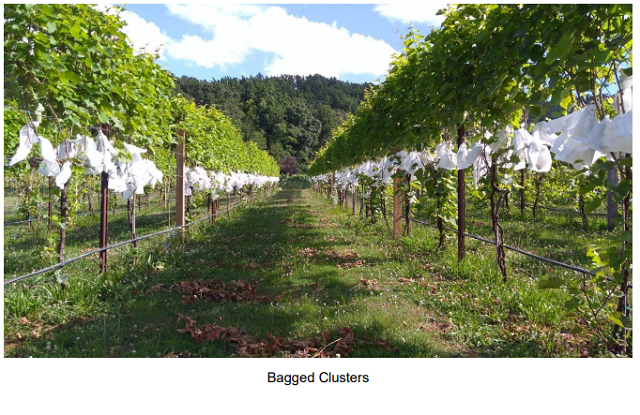The Impact of Bagging Grape Clusters on Grape Ripening and Quality (in Collaboration with VT) (2017)
Karl Hambsch
Loving Cup Vineyard and Winery
Summary and Introduction
This study examines the impact of bagging grape clusters during the growing season on grape and wine flavor, chemistry, microbiology, and phenolics. The vineyard uses organic grape growing practices, and the goal of this project was to see if bagging grape clusters would improve disease resistance without negatively impacting grape and wine quality. The bags used were 19x27cm white paper bags with micropores. Corot Noir grapes in one block experienced 4 treatments: 1) not bagged, 2) bagged at pea-sized berries, 3) bagged at berry touch, and 4) bagged at veraison. Because of a prediction of reduced disease incidence in bagged clusters relative to unbagged clusters, and because unbagged, rotting clusters were going to be dropped during the season, green harvesting of the treatment clusters was undertaken on lagging blooming clusters at berry set in order to attempt to keep crop levels similar between treatments. Lagging clusters were also not bagged on treatment rows. Control and treatment grapes were harvested 2 days apart from each other, and the 3 treatments were combined into one must to ferment. Both control and treatment musts received a 10% saignee, both were inoculated with Renaissance Ossia yeast, and all other treatments between wines were equal. Both bins received 2 weeks extended maceration. Bagging clusters might have reduced incidence of black rot, with the earlier bagging treatments being more effective; however, more intensive work is needed to confirm this. The grape treatments generally exhibited slight increases in berry weight and cluster weight, as well as increases in malic acid, pH, and YAN. Juice and wine chemistry was not much impacted, except that acidity was lowered in the bagged treatment. Bagging clusters lowered the microbial content of the juice, although wine was not much impacted. All phenolic and color parameters, in grape and wine, were either reduced or did not change as a result of bagging. 64% of people were able to distinguish the wines in triangle testing, suggesting a statistically significant difference between them (p<0.001). Of those who correctly distinguished between the wines, there was not a major preference for one wine over the other, perhaps slightly favoring no bags. There were strong trends for the unbagged treatments to have higher Overall Aromatic Intensity and higher Acidity. There was a slight tendency for Fruit Intensity to be higher in the unbagged treatments as well.
Results and Discussion
Bagging clusters might have reduced incidence of black rot, with the earlier bagging treatments being more effective; however, more intensive work is needed to confirm this. The grape treatments generally exhibited slight increases in berry weight and cluster weight, as well as increases in malic acid, pH, and YAN. Juice and wine chemistry was not much impacted, except that acidity was lowered in the bagged treatment. Bagging clusters lowered the microbial content of the juice, although wine was not much impacted. All phenolic and color parameters, in grape and wine, were either reduced or did not change as a result of bagging.
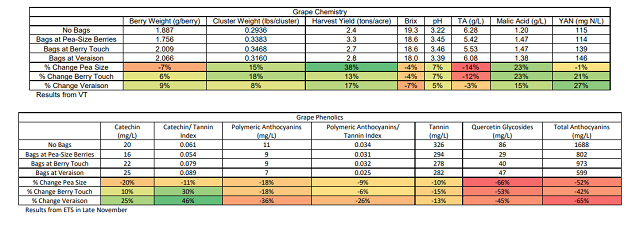
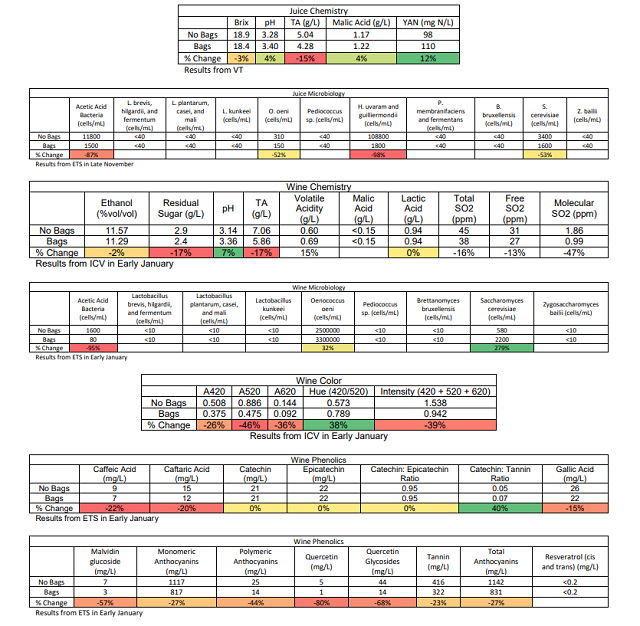
For the triangle test, of 33 people who answered, 21 people chose the correct wine (64%), suggesting a statistically significant difference between wines (p<0.001). These wines were voted to have an average degree difference of 5.4 (out of 10), suggesting that the wines were moderately different. In general, people who answered correctly did not have a major preference for one wine over the other, with a slight preference for the unbagged wine. This was different from what people said during the tasting (where most people preferred the unbagged treatment), suggesting that many who got the triangle test wrong preferred the treatment without bags. For the descriptive analysis, there were strong trends for the unbagged treatments to have higher Overall Aromatic Intensity and higher Acidity (LSD=0.32 and 0.53, respectively). There was a slight tendency for Fruit Intensity to be higher in the unbagged treatments as well.
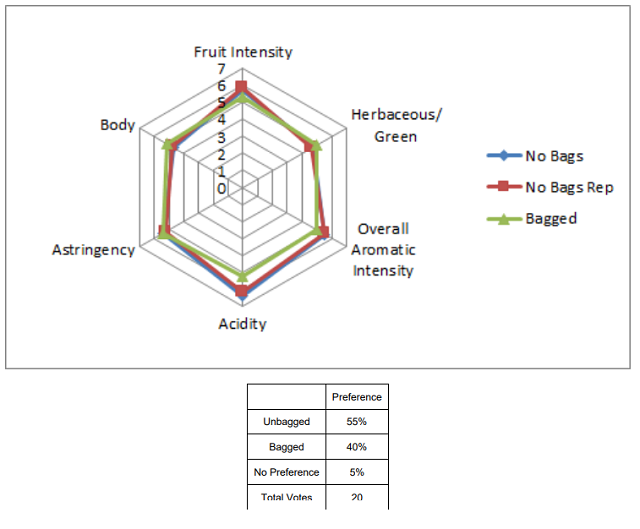
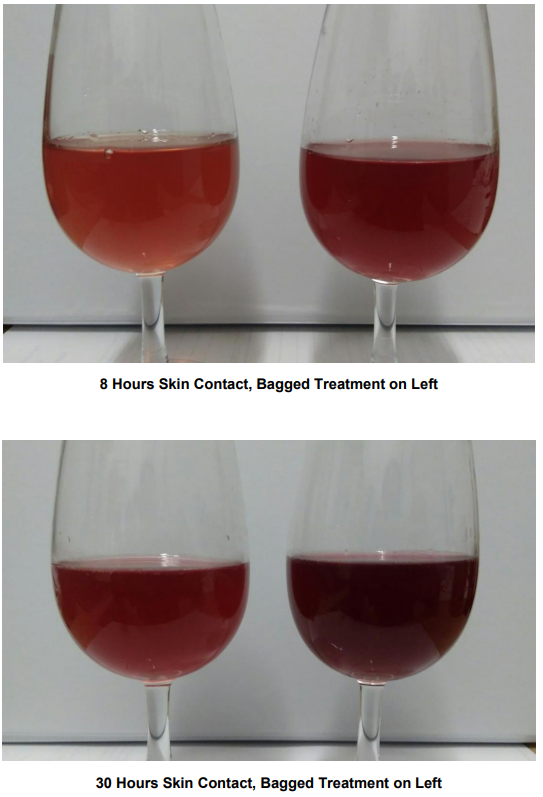
This study suggests that bagging grape clusters during the growing season may be beneficial in reducing black rot disease pressure, but this comes at the expense of phenolic ripeness. Bags also seem to affect the acid profile of the grapes in unusual ways, and in the future more aspects of acidity (such as potassium and tartaric acid) should be examined. Bags seemed to beneficially impact juice microbiology, decreasing the load of acetic acid bacteria and non-Saccharomyces yeasts, but this did not seem to impact the wine much except for a continued low presence of acetic acid bacteria. In spite of considerable lightness in color and a decrease in phenolic compounds in the bagged treatments, there was only a slight preference for the unbagged treatments. More work should be performed on this, over multiple vintages, in order to gain better insight into how grape and wine quality is affected. More rigorous preference and descriptive analysis should be performed on these wines as well. Although it has drawbacks, bagging clusters may potentially be of use in organic vineyards, but more studies are needed.
Methods
A vineyard block of Corot Noir was split so that some rows received bags which covered clusters, whereas others did not. Vines were 8 years old, with a spacing of 5’ X 11’. Vines are planted on 5C or SO4 rootstock, which are fairly similar. The original training system had been GDC, but they have been altered to modified ballerina, 7 feet canopy height. Vines were pruned to two 8-node canes. Approximately 30% vine gaps.
There were three bagging treatments in terms of timing of bagging: pea-size, berry-touch (when bunches close), and veraison. The bags were sourced from a Laizhou Demeter Paper Company in Shandong, China, and they were 19x27cm and 38g white paper bags with micropores and with embedded metal wire (like twist tie) at the closure. Cost per bag (including shipping) is 4.5 cents. They are manufactured for medium size grape clusters. Entire rows were bagged. Because bagging clusters is supposed to greatly reduce disease incidence, another difference between treatments is that the bagged clusters were not cluster thinned due to disease pressure, whereas the control was. This difference was attempted to be overcome by green harvesting clusters still in bloom during fruit set on the treatment rows only (to try to mimic how much would be dropped in the control block). The goal was to reduce lagging clusters in a way similar to green harvesting. Lagging clusters were also not bagged on the treatment rows. Choosing to green harvest rather than harvest at flowering likely did not impact berry or cluster weight.
There was low disease incidence and low spotty wing drosophyla incidence but still sprayed two post-veraison Entrust sprays separated by 7 days. No fungicide sprays into the fruit zone post-veraison but one spray into top of canopy for downy mildew.
Virginia Tech grad students came the day before harvest and randomly selected 200 clusters from each row for evaluation for disease incidence and severity. The clusters were weighed after evaluation. The unbagged grapes were harvested on August 28, and the bagged grapes were harvested on August 31. The unbagged clusters were picked first due to anticipation of a multi-day rain event, and the bagged clusters were harvested after the rain. However, bags on the fruit eliminated contact of water with the fruit, which likely greatly reduced the effect of rain on berry dilution. Fruit remained in cold storage until September 2, at which time they were destemmed and hand sorted into 0.75 ton macrobins. At this time, berry sampling for analysis was performed as follows. A sample cup was placed under the destemmer to catch berries falling onto the sorting table. As each lug of grapes was dumped into the hopper, one sample cup was filled with destemmed berries--so in this way, a composite berry sample was achieved by evenly distributing the sampling over all of the lugs from that row. Each composite sample was collected into a 1 gallon freezer Ziploc bag. About 9 hours later, the contents of each bag were transferred to a large Nalgene beaker and squished by hand for 5 mins. The juice from each bag was immediately drained after squishing so all samples received an equal amount of skin contact. The WRE juices samples were composites created from the individual row samples. The samples were immediately frozen.
10% juice was bled from both bins 10 hours later. Both bins received 5g/hL Renaissance Ossia yeast, 8g/hL Primaflora VR, and 20g/ton Lallzyme EX. The next day (after bins had warmed up), 15g/hL more Renaissance Ossia yeast was added. On 9/6 and 9/7, Fermaid O was added at 20g/hL and 40g/hL, respectively (due to low YAN). Opti-Red was also added at 40g/hL. Punchdowns were 3-4 times per day during fermentation, and 1-2 times per day after fermentation.
Both bins received 2 weeks extended maceration and were then pressed off. After 2 days of settling, the wine was barreled down in identical new barrels. MBR 31 Malolactic bacteria was added at 1g/hL 3 days after barreling. 30 days later, after malolactic conversion completed, barrels were topped and sulfured at 50ppm. Barrels were topped again two weeks later. WRE samples were taken from auto-siphoning directly from barrels into bottles. 15ppm sulfur dioxide was added to each bottle individually.
These wines were tasted on January 31, 2018. For the triangle test, descriptive analysis, and preference analysis, anybody who did not answer the form were removed from consideration for both triangle, degree of difference, and preference. Additionally, anybody who answered the triangle test incorrectly were removed from consideration for degree of difference and preference. Additionally, any data points for preference which did not make sense (such as a person ranking a wine and its replicate at most and least preferred, when they correctly guessed the odd wine) were removed.
In order to balance the data set to perform statistical analysis for descriptive analysis, any judge who had not fully completed the descriptive analysis ratings were removed. In order to then make the number of judges between groups equivalent, one judge from group 1 and group 3 were transferred to group 2, and another judge from group 1 was eliminated. This resulted in a final data set of 3 groups, each with 9 judges (considered as replications within groups, and groups were considered as assessors). Data was analyzed using Panel Check V1.4.2. Because this is not a truly statistical set-up, any results which are found to be statistically significant (p<0.05) will be denoted as a “strong trend” or a “strong tendency,” as opposed to general trends or tendencies. The statistical significance here will ignore any other significant effects or interactions which may confound the results (such as a statistically significant interaction of Judge x Wine confounding a significant result from Wine alone). The descriptors used in this study were Fruit Intensity, Herbaceous/Green, Overall Aromatic Intensity, Acidity, Astringency, and Body.
